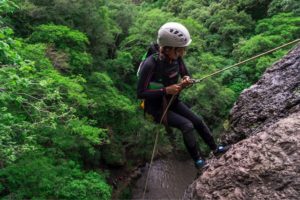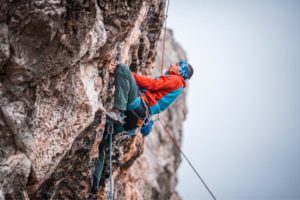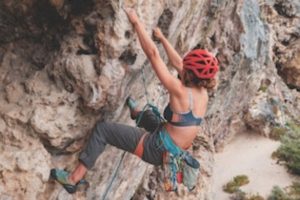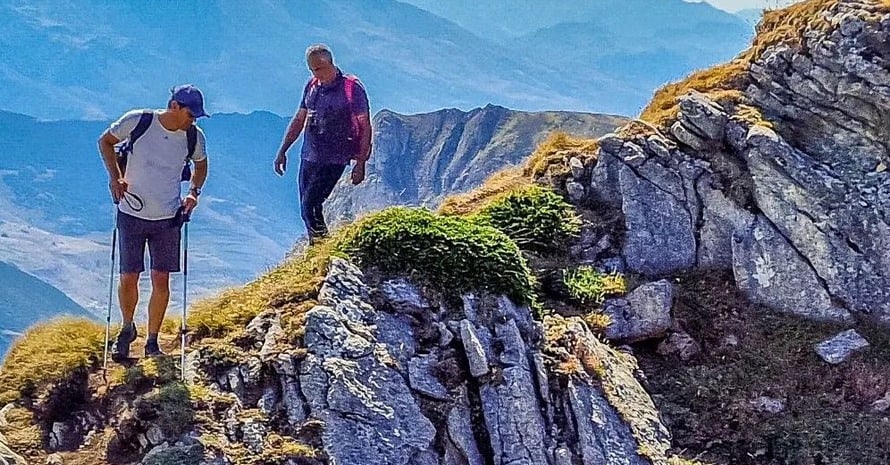Top rope soloing with a grigri is an advanced technique; it can be pretty dangerous because it allows you to self-belay.

It would be best if you also got the participation of a climbing partner to assist you in climbing.
The grigri is one of the world’s most popular belay devices.
Since its first version was released, it has gained popularity due to its excellent braking ability and versatility.
However, as expected, its use still requires in-person practice and many hours doubling down with a professional.
This article will tell you all you need to know about top rope soloing with a grigri. So, let’s get into this now, shall we?
What is Top Rope Solo Climbing?
For the trained or the experienced, nothing beats the adrenaline surging through your veins or the cold air on your skin, making the entire experience a total bliss.
But for the newbie, it can be quite a daunting experience.
Top rope soloing with a grigri requires the participant to have a solid background in rock climbing and much guidance to avoid injuries, and these injuries can be severe in many cases.
A belayer participates in top rope solo climbing (Someone who controls the security rope/Safety Harness attached to the complete rope anchor system; and the climber).
The solo version removes the participation of the belayer.
This is also the difference between top rope solo climbing “Solo as in Single” and regular top roping.
It involves an individual ascending while secured with a tie in a knot to one end of the rope.
At the same time, the belayer or the belay (as it is applicable in top rope soloing) helps to manage the rope’s slack.
In top rope solo climbing, the climber is connected to a fixed rope that moves as he climbs the rock.
When the climber gets to the top of a cliff by hiking, and where lead climbing is no option, they often result to top roping on the routes where they can reach an anchor (A gear that is safely fastened to the rock wall).
How, Then, does a Grigri Come into the Picture?
As for all you need to know about top rope soloing, the grigri itself is a belay and an assisted braking device primarily used in rock climbing.
It is to maintain a safe and effective climbing system, using climbing ropes and harnesses.
Since it was innovated in 2011, there have been a couple of improvements, but the primary function remains the same.
A first-time user should seek professional assistance before using the grigri for rock climbing.
It is also important to note that each version of the grigri is only compatible with ropes of specific diameters.

What is Assisted Braking?
The term “Assisted Braking” has been repeatedly mentioned in this text, but what does it mean?
In top rope solo climbing, these assistant braking devices are the most preferred by most climbers, as most climbing gyms use ABDs in belaying.
Assistant braking devices assist the belayer in catching the climber and breaking a fall.
Grigris mostly come with an internal cam that rotates and hooks the climbing rope in case it moves quickly through the device.
This action complements the belayer in catching an accidental fall.
In top rope solo climbing with a grigri, it is common to see many mistaking the terms “Assisted braking” and “Automatic braking” for each other.
It is good to note that the grigri is not an automatic braking device.
However, as is the norm with non-assisted braking devices, users must keep a hand on the breaking stand of the rope while using the Grigri.
How Do You Use Grigri for Rope Solo?
It is known as top rope soloing with a grigri for a reason. In this section, we shall outline the different simple ways to use a Grigri when next you are out rock climbing.
The device’s significant advantage is the clutch mechanism that helps you brake quickly by pinching the rope when it’s moving too fast.
The grigri device makes top rope solo much easier.
Using a belaying device outdoors is much more complex, given that rock climbing is mainly done on uneven ground.
Then you would still have to battle with falling rocks, wind, insects, dogs, intense sunlight and stray children in some instances.
The device functions like your average car seat belt for top rope soloing with the grigri.
Each device has a cam through which you must have fed the rope earlier. This cam also rotates and pinches the cord, so it breaks the climber’s fall.
It also allows those around to hold the climber while they rest easily. Below are some considerations or boxes that must be ticked before using a grigri.
Ensure You Get the Suitable Rope Diameter for Your Grigri
If you want to go top rope soloing with a grigri and do that successfully, one of the first things to note is that your grigri is designed to work with specific rope diameters.
Other assisted braking devices have different specifications, so it is best to check the manufacturer’s instructions before using them.
All of these, to a large extent, also depend on the model of grigri you purchase, as there are different rope diameters assigned to them.

Feed Your Climbing Rope inside the Cam in the Grigri
Remember we once mentioned the “Cam” of the grigri earlier on? It is the U-shaped device in the middle of the grigri through which the belaying ropes slide.
To properly feed in your rope, all you need to do is to flip the moving side open to see the cam.
Afterwards, feed the rope through the space between the cam and the moving side plate and then loop it under the cam.
When you are done, flip the slide place to cover the rope, and you are ready.
Proceed to Clip a Screw Gate Carabiner to the Belay Loop on the Harness
There is also a carabiner that comes with the grigri. Press it open, then clip it through the attachment holes on both sides of the grigri’s plates.
After this, screw the cylindrical piece into place and over the carabiner’s gate to set it in place so it would get unhooked easily.
Tie a Knot at the End of the Braking Rope
It is just better to ensure you get your climbing rope into a secure and tight knot before climbing.
Tie a solid climbing knot at the end of the rope coming out of the grigri.
This will serve as a braking rope if the string starts sliding out of the grigri and you run out of slack.
After tying all your knots and doing all the necessary fixes, test the system under your weight to ensure it can safely carry you.
Make sure nothing comes off unnecessarily and that the devices do not interfere with each other before you start climbing.
Safety Tips to Consider for Top Rope Solo Climbing
Going top rope soloing without a human partner or professional can be dangerous. Rope soloing is a hard way to climb.
This is without mincing words, but it gets better with proper training, preparation, and close attention to the backup knots and other safety checks.
Climbers have often mentioned the need to overcome the mental challenge of climbing without assistance or the checks of others.
This is because anything can happen, and you find yourself needing help.
Other safety considerations to consider include the following:
- Double your equipment: Using two ascender devices that work on different principles from each other will reduce the possibility of both failing in an accident.
- Maintain a straight route: You cannot go wrong with maintaining a straight course while climbing. This helps to minimize the number of times the rope might get in the way or peel while climbing.
- Ensure to use a backup rope: This is for your safety, so before you go top rope soloing with a grigri, you must try to use more than one rope. This second rope will be a backup to absorb the shock generated by a primary system failure.
Conclusion
Top rope soloing with a grigri is such a high-impact activity—all the bliss and the rush that comes with it also with the risks of severe injury.
Hence, practicing and seeking proper guidance before embarking on such activity is pivotal.

Some people collect expensive old cars, and I’m into collecting bikes. I have 15 different bikes: special mountain bikes, sportbikes, professional, amateur, and city bikes. My friends and colleagues call me a ‘bike expert’ because I give advice on how to choose the right bike.
I’m also a massive fan of gym culture and heavyweight workouts. I met Alan at my local gym, and we’ve become friends quite soon. His idea of starting a sports blog seemed interesting to me, so I agreed to help.





